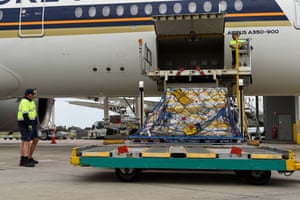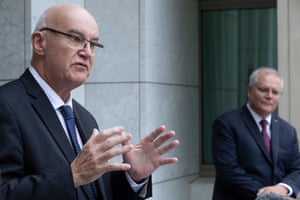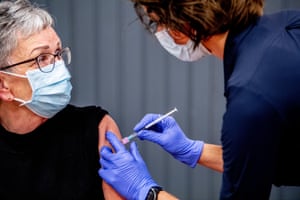Australia received its first delivery of Covid-19 vaccines on 15 February, and has begun the mammoth task of immunising every willing adult in the country.
However the vaccine rollout has already fallen behind goals the government set itself, with just over 105,000 doses administered as of 10 March – tens of thousands of doses short of even the more modest benchmarks set.
It is the largest single vaccination program in Australia’s history and many still have questions about how the process will work and, most importantly, when they can expect to get the jab.
Here is what we know so far.
Who will get this first delivery of vaccines and when?
On 15 February a Singapore Airlines flight touched down in Sydney carrying 142,000 doses of the Pfizer/BioNTech vaccine.
While the first doses were administered on 21 February, including to prime minister Scott Morrison, the ongoing supply to each state varies based on their proportion of the highest priority group. The Northern Territory, for example, has said it expects to receive about 3,000 doses in the first phase of the rollout.
The first people to receive the vaccination have been thousands of frontline quarantine and health workers who interact with returned international travellers, and staff and patients in aged and disability care.
Despite the government indicating the February arrival of vaccines was “slightly ahead of schedule”, the government has repeatedly failed to meet key vaccination targets it has set itself since the beginning of the year.

Who is responsible for what?
The federal government is responsible for Australia’s Covid-19 vaccination supply.
That includes selecting, buying and regulating – through the Therapeutic Goods Administration (TGA) – the various vaccines Australians will have access to.
But now that the first shipments of the vaccines have arrived, the states have a role to play.
Out of the first shipment, the federal government is responsible for administering the vaccines to staff and residents in aged care, which Hunt said would include 240 aged care facilities in rural and urban areas in each state and territory.
The states, meanwhile, will begin rolling out the vaccine to frontline workers.
Do we have enough vaccine doses?
Yes, now that Hunt has confirmed the Oxford/AstraZeneca vaccine has been “cleared for lift-off” and approved by the TGA, Australia will have enough vaccine doses to immunise every adult in Australia and then some.
Australia hopes to buy three different vaccines: the Pfizer/BioNTech, Oxford/AstraZeneca, and Novavax, the latter which has yet to be approved anywhere in the world.
Currently, Australia has entered into contracts to acquire 53.8m doses of the AstraZeneca vaccine. The drug requires two doses per person, meaning we will theoretically have enough to vaccinate the entire adult population with this vaccine alone.
Around 1.2m doses will be imported from overseas, but the bulk – about 50m – are to be manufactured by Melbourne-based biotechnology company CSL.
The TGA said older Australians should be given AstraZeneca on a “case by case” basis, but John Skerritt from the TGA said on Tuesday that the majority of people could still receive it.
“If someone only has a few weeks to live, you won’t give them a hip replacement and may not give them a vaccine. So that’s what we’re talking about, but the vaccine is recommended for use in all ages,” he said.

On top of those 53.8m doses, we have also been promised at least 20m doses of the Pfizer vaccine, which has already been approved for use by the TGA and has been shown to be 95% effective in preventing disease.
Australia originally secured 10m doses but this was doubled in February.
This is enough to vaccinate 10 million people as it requires two doses to be effective. This will be the first vaccine rolled out in Australia, but the distribution of this drug is considerably more expensive and complicated than others, given the requirement to keep the product at minus 70C.
Australia has also signed an agreement to buy 51m doses of the Novavax vaccine during the first half of the year, enough to vaccinate the entire adult population. Novavax is still undergoing clinical trials, so this deal may fall through, but current results suggest it is around 89% effective.
Finally, Australia is part of the Covax facility program, which is an international agreement in which Australia paid $123.2m upfront to have access to up to 25m vaccine doses as vaccines are developed and approved. As part of this agreement, Australia has provided $80m in funding for vaccine programs in the developing world.
This program could help supply Australia with additional doses from nine vaccine candidates.
No vaccine has so far been approved for use in children, with Pfizer approved for those 16 and older, and AstraZeneca 18 and above. It’s still unclear how important vaccinating this age group will be given low infection and transmission rates.
When will the rest arrive?
Hunt said 1m AstraZeneca doses a week would be made available by the end of March, with the distribution of the drug beginning around the same time. The first doses administered were those shipped from overseas.
There were fears that Australia’s vaccine supply doses would be trapped overseas after the European Union declared they would need to give approval before any shipments were exported. At the beginning of March, Italy blocked 250,000 doses of the AstraZeneca vaccine to Australia under the EU’s export authorisation scheme.
But Australian health officials say Italy’s action won’t halt the vaccine rollout, thanks to the ability to produce AstraZeneva onshore.
Few details on the delivery of the Novavax vaccine have been released, but this vaccine may be several months away given it is still undergoing clinical trials.
Will the vaccine be free?
Yes.
Will the vaccine be voluntary?
Yes, and the government has confirmed that not getting the vaccine will not affect a family’s eligibility for the family tax benefit or fee assistance with childcare. The “no jab no play” rules only apply to the National Immunisation Program vaccines, and the Covid-19 vaccine will not be included in this.
Who will get what and when?
The federal government has unveiled a four- (or possibly five) stage vaccine rollout plan, with a fairly confusing naming system. Official start dates for these “phases” have not been released but Australia is aiming to have all of phase 1a and more than half of phase 1b – around 4 million people – vaccinated by the end of April.
Phase 1a: The first people receiving the vaccine are quarantine and border workers, priority frontline healthcare workers, and staff and residents at aged care and disability centres. In total this will cover about 678,000 people and will probably use around 1.4m doses of the Pfizer vaccine, with the government leaving a pretty comfortable margin for error.
Phase 1b: This is the first large-scale rollout to the general public. The following groups will be eligible: everyone over 70, other healthcare workers, Aboriginal and Torres Strait Islander people over 55, adults of any age with underlying medical conditions which make them vulnerable to the virus, and certain high-risk workers including army, police and those working in meat processing plants. This will cover around 6.14 million people and use up to 14.8m doses of mostly the AstraZeneca vaccine.
Phase 2a: Next the vaccine will be available to people in their 60s and 50s, all adult Aboriginal and Torres Strait Islander people, and all other critical and high-risk workers. This will cover 6.57 million people and use up to 15.8m doses of what will probably be the AstraZeneca vaccine.
Phase 2b: This will cover the rest of the Australian adult population, around 6.64 million people using up to 16m doses. This will probably be the AstraZeneca vaccine, although it’s possible the Novavax vaccine may be available if it proves effective.
Phase 3: This will cover all Australians under 18 if vaccinating children is recommended at that point. This will cover 5.67 million people and use up to 16m doses. At this point, there is no vaccine approved for use in Australia on children. Pfizer can so far only be administered to those 16 and older, and AstraZeneca, 18 and above.

When will everyone be vaccinated?
The government has stated for several months that they hope to have all adults who wish to be vaccinated immunised by the end of October. They’re sticking with that deadline, despite the start of the rollout being a bit behind schedule.
Can I apply to receive one of the early doses?
No.
The government has begun contacting people eligible for vaccination in phase 1a.
Frontline workers will have their vaccinations organised by their workplaces, given a large proportion are directly employed by the government.
Aged and disability care facilities are now seeking pre-approval from residents or their families for the vaccine, in order to ensure the doses can be delivered quickly and efficiently once they leave subzero storage facilities on the day.
The Queensland health department has also advised those in priority groups will be “identified … based on your level of risk and invited to register for a vaccine, if you wish to receive one”.
The exact details of how the vaccines from phase 1b onwards will be rolled out have yet to be released, but the federal health department has referenced a “national booking system” for the Covid-19 vaccine.
Health minister Greg Hunt said the aim was for bookings to be as easy as possible.
“Our goal for the public is to have a very simple access approach. So, as you can phone your GP, you can phone the state clinic, or you can come through a single front door,” he said.
The government aims to work with states and territories to ensure those who are a priority for vaccination are provided with targeted communications. Key industry groups, peak bodies and health providers will be important in helping to communicate with older or vulnerable groups about how to receive the vaccine.
The government has so far invested $23.9m in a communications campaign designed to provide information about when and where people can get the jab.
Should I call my GP now to book?
No, not just yet. As the government works on a booking system, and GPs are trained for administering the vaccine, clinics aren’t in a position yet to book appointments for vaccines.
Can I pay to get vaccinated earlier?
No. So far, Australians are only able to receive a Covid-19 vaccine through official channels. Any group offering to sell early access to a vaccine is not authorised by the government, and likely a scam.
Where will you go to get vaccinated?
One of the defining features of the early vaccine rollout is the need for the Pfizer vaccine to be stored and transported at minus 70C.
As such, the federal government has established around 46 hubs in urban and rural Australia. These are generally located in the major hospitals of cities and large regional towns.
Priority healthcare and border force workers will visit these hubs to get vaccinated, and doses for health and disability care patients will be picked up from the hospital on the day of vaccination and delivered by members of the trained vaccine workforce to the facility where it will be administered.
NSW Health has previously said, “once more vaccine doses become available from phase 1b, it is expected that one or more Covid-19 vaccines will be available for the wider population through usual immunisation providers, including GP practices, GP respiratory clinics and Aboriginal health services”.
The federal government plans to establish about 1,000 vaccine hubs around the country. This process will be eased by the rollout of the AstraZeneca vaccine, which only requires regular refrigeration during transportation and storage.
Hunt has also stated that from phase 2 onwards pharmacists would also be assisting in distributing and administering vaccine doses.
What will the process of getting vaccinated be like?
After booking your time to be vaccinated you will probably travel to your local hospital, GP or designated vaccination centre.
According to the government’s vaccine rollout guide, you will first be “screened”, presumably to confirm you are healthy and eligible. You will then be given the first dose of the vaccine along with information about any potential side-effects and when you will need to return to receive your second dose.
You will have to be monitored for a short period of time before you leave and your details will then be entered into the Australian Immunisation Register.
Several weeks later you will then receive a call reminding you of the date and location of your second dose. For the Pfizer vaccine, this will be three weeks after the first injection, and 12 weeks for AstraZeneca vaccine.
The vaccination process will be repeated for your second dose.
You may experience some side-effects after getting the Pfizer vaccine, but these will almost always resolve after two days, according to the TGA.
They found more than 60% will experience fatigue, 50% will develop a headache, more than 30% will suffer muscle pain or chills and more than 20% will experience joint pain, but the regulatory body has ruled that the benefits of receiving the vaccine well outweigh the minor discomfort this may cause.
Of those injected with the first dose of AstraZeneca, 50% will experience injection site pain, headaches and fatigue, 30% may develop a fever or chills and 20% may have joint pains or nausea.
Again, the majority of these side effects are mild to moderate and usually resolve within a few days. The second dose is associated with significantly less adverse effects.
-
Due to the unprecedented and ongoing nature of the coronavirus outbreak, this article is being regularly updated to ensure that it reflects the current situation at the date of publication. Any significant corrections made to this or previous versions of the article will be footnoted in line with Guardian editorial policy.
